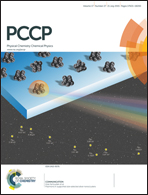Electronic structures of anatase (TiO2)1−x(TaON)x solid solutions: a first-principles study†
Abstract
Sensitizing wide band gap photo-functional materials under visible-light irradiation is an important task for efficient solar energy conversion. Although nitrogen doping into anatase TiO2 has been extensively studied for this purpose, it is hard to increase the nitrogen content in anatase TiO2 because of the aliovalent nitrogen substituted for oxygen, leading to the formation of secondary phases or defects that hamper the migration of photoexcited charge carriers. In this paper, electronic structures of (TiO2)1−x(TaON)x (0 ≤ x ≤ 1) solid solutions, in which the stoichiometry is satisfied with the co-substitution of Ti for Ta along with O for N, are investigated within the anatase crystal structure using first-principles calculations. Our computational results show that the solid solutions have substantially narrower band gaps than TiO2, without introducing any localized energy states in the forbidden gap. In addition, in comparison with the pristine TiO2, the solid solution has a direct band gap when the content of TaON exceeds 0.25, which is advantageous to light absorption. The valence band maximum (VBM) of the solid solutions, which is mainly composed of N 2p states hybridized with O 2p, Ti 3d or Ta 5d orbitals, is higher in energy than that of pristine anatase TiO2 consisting of non-bonding O 2p states. On the other hand, incorporating TaON into TiO2 causes the formation of d–d bonding states through π interactions and substantially lowers the conduction band minimum (CBM) because of the shortened distance between some metal atoms. As a result, the anatase (TiO2)1−x(TaON)x is expected to become a promising visible-light absorber. In addition, some atomic configurations are found to possess exceptionally narrow band gaps.


 Please wait while we load your content...
Please wait while we load your content...